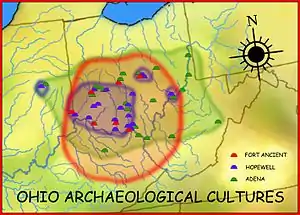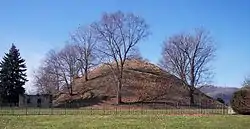Adena culture
The Adena culture was a Pre-Columbian Native American culture that existed from 800 BC to 1 AD, in a time known as the Early Woodland period.[1] The Adena culture refers to what were probably a number of related Native American societies sharing a burial complex and ceremonial system. The Adena culture was centered on the location of the modern state of Ohio, but also extended into contiguous areas of northern Kentucky, eastern Indiana, West Virginia, and parts of extreme western Pennsylvania.[1]
 Geographic distribution of the Adena (800 BCE–100 AD), Hopewell (200 BCE–500 AD), and Fort Ancient (1000–1750 AD) cultures. | |
| Geographical range | Midwestern United States |
|---|---|
| Period | Early Woodland period |
| Dates | 800 BC to 1 AD |
| Type site | Adena Mound |
| Major sites | Criel Mound, Grave Creek Mound, and Miamisburg Mound |
| Preceded by | Archaic period |
| Followed by | Ohio Hopewell |
Importance
The Adena culture was named for the large mound on Thomas Worthington's early 19th-century estate located near Chillicothe, Ohio,[2] which he named "Adena",
The culture is the most prominently known of a number of similar cultures in eastern North America that began mound building ceremonialism at the end of the Archaic period. The geographic range of the Adena sites is centered on central and southern Ohio, with further sites in contiguous areas of the surrounding states of Indiana, Kentucky, West Virginia and Pennsylvania. The importance of the Adena complex comes from its considerable influence on other contemporary cultures and cultures that came after it[3] The Adena culture is seen as the precursor to the traditions of the Hopewell tradition, which are sometimes thought as an elaboration, or zenith, of Adena traditions.
The Adena were notable for their agricultural practices, pottery, artistic works, and extensive trading network, which supplied them with a variety of raw materials, ranging from copper from the Great Lakes to shells from the Gulf Coast.[4][5][6]
Art and religion
Mounds
Lasting traces of Adena culture are still seen in the remains of their substantial earthworks. At one point, larger Adena mounds numbered in the hundreds, but only a small number of the remains of the larger Adena earthen monuments still survive today. These mounds generally ranged in size from 20 feet (6.1 m) to 300 feet (91 m) in diameter and served as burial structures, ceremonial sites, historical markers, and possibly gathering places. These earthen monuments were built using hundreds of thousands of baskets full of specially selected and graded earth. According to archaeological investigations, Adena earthworks were often built as part of their burial rituals, in which the earth of the earthwork was piled immediately atop a burned mortuary building. These mortuary buildings were intended to keep and maintain the dead until their final burial was performed. Before the construction of the earthworks, some utilitarian and grave goods would be placed on the floor of the structure, which was burned with the goods and honored dead within. The earthwork would then be constructed, and often a new mortuary structure would be placed atop the new earthwork. After a series of repetitions, mortuary/earthwork/mortuary/earthwork, a quite prominent earthwork would remain. In the later Adena period, circular ridges of unknown function were sometimes constructed around the burial earthworks.[3]
Prominent mounds
| Site | Image | Description |
|---|---|---|
| Adena Mound |  |
The Adena Mound, the type site for the culture, is a registered historic structure near Chillicothe, Ohio. |
| Biggs Site |  |
The site, located in Greenup County, Kentucky, is a conical abide surrounded by a series of circular ditches and embankments. It is connected to the Portsmouth Earthworks directly across the Ohio River in Portsmouth, Ohio.[7][8] |
| Criel Mound |  |
A 35-foot (11 m) high and 175-foot (53 m)-diameter conical mound, it is the second largest of its type in West Virginia. It is located in South Charleston, West Virginia. P. W. Norris of the Smithsonian Institution oversaw the excavation. His team discovered numerous skeletons along with weapons and jewelry.[9] |
| Enon Mound |  |
Ohio's second largest conical burial mound, it is believed to have been built by the Adena. |
| Grave Creek Mound |  |
At 62 feet (19 m) high and 240 feet (73 m) in diameter, it is one of the largest conical-type burial mounds in the United States. It is located in Moundsville, West Virginia. In 1838, much of the archaeological evidence in this mound was destroyed when several non-archaeologists tunneled into the mound.[9][10] |
| Miamisburg Mound |  |
Once serving as an ancient burial site, the Miamisburg Mound is the most recognizable landmark in Miamisburg. It is the largest conical burial mound in Ohio, and remains virtually intact. Located in a city park at 900 Mound Avenue, it is an Ohio historical site and serves as a popular attraction and picnic destination for area families. Visitors can climb to the top of the mound via stone-masonry steps. |
| Wolf Plains Group |  |
A Late Adena group of 30 earthworks including 22 conical mounds and nine circular enclosures.[11] It is located a few miles to the northwest of Athens, Ohio. |
Stone tablets
The Adena also carved small stone tablets, usually 4 or 5 inches by 3 or 4 inches by .5 inches thick. On one or both flat sides were gracefully composed stylized zoomorphs or curvilinear geometric designs in deep relief. Paint has been found on some Adena tablets, leading archaeologists to propose that these stone tablets were probably used to stamp designs on cloth or animal hides, or onto their own bodies.[12] It is possible that they were used to outline designs for tattooing.[13]
Pottery
Unlike in other cultures, Adena pottery was not buried with the dead or the remains of the cremated, as were other artifacts. Usually Adena pottery was tempered with grit or crushed limestone and was very thick; its decoration was largely plain, cord-marked or fabric marked, although one type bore a nested-diamond design incised into its surface. The vessel shapes were sub-conoidal or flat-bottomed jars, sometimes with small foot-like supports.[14]
Domestic life
Settlement patterns
The large and elaborate mound sites served a nearby scattering of people. The population was dispersed in small settlements of one to two structures. A typical house was built in a circle form from 15 to 45 feet in diameter. The walls were made of paired posts tilted outward, that were then joined to other pieces of wood to form a cone shaped roof. The roof was then covered with bark and the walls may have been bark and/or wickerwork.[15]
Food sources
Their sustenance was acquired through foraging and the cultivation of native plants.
Tools
The Adena ground stone tools and axes. Somewhat rougher slab-like stones with chipped edges were probably used as hoes. Bone and antler were used in small tools, but even more prominently in ornamental objects such as beads, combs, and worked animal-jaw gorgets or paraphernalia. Spoons, beads and other implements were made from the marine conch. A few copper axes have been found, but otherwise the metal was hammered into ornamental forms, such as bracelets, rings, beads, and reel-shaped pendants.[14]
See also
References
- "Adena Culture". Ohio History Central. Ohio History Connection.
- "Identifying Flint Artifacts/Early Woodland People". Retrieved 2008-09-12.
- "Native Peoples of North America–Adena". Archived from the original on 20 September 2008. Retrieved 2008-09-12.
- "Civilizations Of The Americas, The Peoples To The North". Archived from the original on 2009-05-10. Retrieved 2008-09-11.
- "Early Woodland: Northeastern Middlesex Tradition". Retrieved 2008-09-11.
- "Grave Creek Mound Archaeological Complex". Retrieved 2008-09-11.
- "Portsmouth Earthworks-Ohio Central History". Retrieved 2008-09-11.
- Lewis, R. Barry (1996). Kentucky Archaeology. University Press of Kentucky. ISBN 978-0-8131-1907-6.
- "Mounds and Mound Builders". Archived from the original on 2008-06-23. Retrieved 2008-09-11.
- Hemmings, E. Thomas (1984). "Investigations at Grave Creek Mound 1975-1967: A Sequence for Mound and Moat Construction". West Virginia Archeologist. 362: 3–49.
- "The Archaeological Conservancy-2008 Annual Report" (PDF). Archived from the original (PDF) on 2011-07-07. Retrieved 2010-02-03.
- Power, Susan (2004). Early Art of the Southeastern Indians-Feathered Serpents and Winged Beings. University of Georgia Press. pp. 29–34. ISBN 978-0-8203-2501-9.
- "Virtual First Ohioans".
- "Adena Site". Archived from the original on 2009-05-09. Retrieved 2008-09-12.
- "The Adena Mounds". Archived from the original on 2 October 2008. Retrieved 2008-09-12.
- "NA Archaeology : Adena". Archived from the original on 2008-06-27. Retrieved 2008-09-12.
- Whitaker, Alex. "The Mound Builders". www.ancient-wisdom.com. Retrieved 2017-04-09.
External links
| Wikimedia Commons has media related to Adena culture. |
